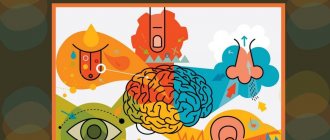Sphere of attention
Concentration of consciousness is not all-encompassing. Only those objects, the study of which is determined by some necessity, fall into the sphere of concentration of consciousness. These may be the following circumstances:
- social necessity;
- subjective interest of a person, resulting from his inclinations or field of activity.
The sphere of mental activity is closely interconnected with everyday activities and ensures certain successes in understanding the world, studying, and work. The degree of a person’s learning ability and even his ability to communicate with other people and conflict-free communication depends on it.
This psychological process plays a crucial role both in the process of memorization and in the reproduction of previously recorded images from memory.
Conditions
This mechanism of instant reaction was formed in the process of evolution; it helped weak animals to escape from predators in time, and it also allowed predatory representatives of the fauna to track down prey. Of course, people are not afraid of animals, and to get food, they visit stores. However, when an unexpected stimulus occurs, we respond to it. Now I will list what is the condition for the emergence of involuntary attention:
- movement - an object that is at rest does not pose any danger, and therefore does not act as an irritating factor;
- impact - a strong sound signal or a quiet rustle in an empty room, our consciousness perceives a bright unexpected light as a threat;
- the unknown – it can lead to trouble, so we react to this event.
Varieties (classification of types of attention)
As a result of the study of psychological processes, several varieties of this physiological phenomenon were identified. Each of them has certain characteristics.
The types of attention in psychology are distinguished as follows:
- involuntary;
- arbitrary;
- post-voluntary.
Involuntary view
Its features include the absence of a person’s conscious choice when choosing an object. This becomes possible in the case of a fairly strong irritant that forces one to take a break from selected daily activities. Examples of objects of involuntary concentration can be:
- unexpected noise;
- a new person in the team;
- bright moving object;
- any phenomenon unusual for the current time and place.
Objects that attract involuntary attention distract from everyday activities, cause a strong emotional response, and can make it difficult to perform current tasks and make decisions. High-intensity stimulation can permanently reduce the ability to concentrate (for example, something that causes severe stress, fear). Managing involuntary concentration is quite difficult, since it can be very closely related to subconscious internal attitudes.
This type of attention prevails, as a rule, in children of preschool and primary school age. This is related to the peculiarities of presenting information in preschool institutions and primary schools - in the form of vivid images that arouse the interest of children. This style of presenting material contributes to faster and easier assimilation of information by preschool children, and also creates the basis for the development of their imagination and creative potential due to strong connections with the emotional sphere.
Free variety
The main characteristic of this mental process is conscious concentration on the object of concentration. The main condition for the formation of voluntary attention is the presence of motivation. That is, a person must understand the importance of concentrating on a specific object. Conscious concentration on a specific task requires volitional effort and tension of mental activity. After all, a person must focus on a certain object or task, even if the essence of this phenomenon is not interesting to him (an example would be the need to prepare for an exam at the end of the semester).
The inherent qualities of voluntary concentration of consciousness are stability and perseverance.
Prolonged concentration of voluntary attention is fraught with the development of a state of fatigue and even severe overwork. This is precisely why recommendations are made to take regular breaks during intense intellectual work, going out into the fresh air or doing simple physical exercises.
Reading books during such breaks is not recommended, because by switching the focus of attention from one stream of information to another, the brain will not have time to rest.
Postarbitrary type
This variety is characterized by high motivation to achieve goals. It differs from voluntary concentration in that internal motivation predominates here. Therefore, post-voluntary attention is characterized by the absence of tension of the person performing the task.
It is this type of attention that gives significant results and is highly productive.
Peculiarities
Spontaneous concentration is the primary form of mindfulness, which arises due to external impulses - phenomena, people, objects.
I will indicate the main features of involuntary attention:
- it functions in our subcortex;
- the person does not prepare himself to perceive an unexpected situation;
- the intensity of the response is determined by the shape of the stimulus;
- short duration of concentration on the moment.
Properties of attention
Each of the qualities pursues its own goals. This makes it possible to perform a wide variety of tasks. The characteristics of attention are very closely related to the components of personality:
- Concentration is intentional focus on the task at hand or a given object. A person can effectively focus on a specific object for 30–40 minutes.
- Volume. This refers to the number of tasks or objects that a person can hold in the sphere of sustained concentration.
- Stability is the ability to concentrate on one object or task for a long period of time without switching to other stimuli. If a person tends to be distracted by numerous external stimuli, this is a sign of lability (one of the disorders) of attention.
- Switchability. This is a conscious, voluntary redirection of the focus of attention. As a rule, this property is due to external circumstances. If a shift in attention occurs under the influence of minor changes in the situation and occurs unintentionally, we are talking about a disorder called distractibility. Often, the switchability of attention depends on concentration: with a high degree of concentration, it is quite difficult to switch it from one object to another. Switchability is a necessary parameter, since it is this that provides the opportunity for rest when moving from one type of activity to another.
- Distribution. This property characterizes the ability to concentrate on several objects or tasks at once, of approximately equal importance. The need to distribute attention, as a rule, entails the rapid onset of a state of fatigue.
Neuropsychology
Neuropsychology of attention is a separate field of knowledge that studies issues of concentration, linking them with neural processes. Initially, such studies were carried out exclusively on animals, by connecting electrodes to certain areas of the brain. In order to study the stability of human attention, electroencephalogram technology is used. To do this, the body must be awake. In this way, it is possible to record the excitation or inhibition of nerve impulses during the performance of a certain type of activity. In this context, psychologist E. N. Sokolov plays a huge role. Through a large number of studies, he proved that when performing the same action repeatedly, attention becomes automatic. Thus, the brain stops actively responding to the stimulus, which affects the results of the electroencephalogram. The brain decides that in this case there is no need for excitement, because the body has a certain mechanical memory.
Methods for developing attention
The ability to concentrate is not an immutable, unchanging value. It can be strengthened, developed, trained with the help of exercises developed specifically for this purpose.
Today, there are various techniques for improving the ability of this physiological mechanism:
- development of concentration;
- development of visual concentration;
- development of auditory attention.
Concentration training
Having chosen an arbitrary object for observation at your discretion, it is recommended to concentrate your attention on it for a certain period of time, the duration of which should be gradually increased in the future. The easier the chosen object is to perceive, the easier it will be to cope with the task - this is important for starting training when you are not yet in the habit of concentrating on the object.
An example would be concentrating on a particular book, thinking about who it was written and what it was about, about the characters and plot, about what paper it was made of, what trees were involved in the production process, what color, shape, etc. thickness, format. This exercise is effective for developing focus and increasing the duration of concentration on one object.
By developing the acquired concentration skill, you can train to keep 2, and later more, objects in your sphere of attention. In this case, the ability to retain in memory all the noticed qualities of all objects will be an indicator of training.
A modification of this exercise would be to hold several objects in memory, switching attention from one to another and remembering the key properties of each of them.
Visual attention
This exercise expands your ability to concentrate on a subject. In addition, it develops the ability to notice features that are not obvious at first glance - observation. For example, looking at a certain object for 3-5 minutes, it is recommended to note all its properties and qualities:
- color;
- shape;
- size;
- height;
- material.
For convenience, you can briefly record the characteristics of the object being studied.
The exercise is to identify new details and smallest details while studying the object in more detail. With proper practice, with each new exercise, the list of noticed features of the object will become longer and longer.
There is a theory that this method of developing mindfulness with a systematic approach works at any age, at any period of life and in any occupation. The main condition for success, as with any training, is systematic repetition of the exercises.
Auditory Focus
To train this type of mindfulness, it is recommended to concentrate on sounds. For example, when listening to human speech, concentration on the sounding voice is implied:
- speech rate analysis;
- degree of emotionality;
- the degree of usefulness of the information presented for a particular individual.
With developed auditory concentration, analysis of voice timbre and speech rate does not interfere with the perception of the meaning of what is said.
Sources
- Hii J., Hustedt J., Bangs MJ. Residual Malaria Transmission in Select Countries of Asia-Pacific Region: Old Wine in a New Barrel. // J Infect Dis - 2022 - Vol223 - NSupplement_2 - p.S111-S142; PMID:33906222
- No authors found Reproductive Health Care for Incarcerated Pregnant, Postpartum, and Nonpregnant Individuals. // Obstet Gynecol - 2022 - Vol - NNULL - p.; PMID:33906198
- Liu G., Xiao Y., Zhang W., Tang W., Zuo C., Zhang P., Dong S., Luo P. Novel aluminum vanadate as a cathode material for high-performance aqueous zinc-ion batteries. // Nanotechnology - 2021 - Vol - NNULL - p.; PMID:33906187
- Schmitz M., Kesper L., Schulte MGH., Roese P., Berges U., Westphal C. Surface and interface analysis of a low-dimensional Au-Si surface alloy on Au(110) by means of XPS and XPD. // J Phys Condens Matter - 2022 - Vol - NNULL - p.; PMID:33906167
- Cheng Y., Cao J., Tang X., Hao Q. Optical zoom imaging systems using adaptive liquid lenses. // Bioinspir Biomim - 2022 - Vol - NNULL - p.; PMID:33906161
- Li C., Wang R., Yang X., Zhou M., Pan X., Cai G., Zhang Y., Zhu G. Deeper investigation on methane generation from synthetic wastewater containing oxytetracycline in a scale up acidic anaerobic baffled reactor. // Bioresour Technol - 2022 - Vol333 - NNULL - p.125156; PMID:33906019
- Rahmanti AR., Ningrum DNA., Lazuardi L., Yang HC., Li YJ. Social Media Data Analytics for Outbreak Risk Communication: Public Attention on the “New Normal” During the COVID-19 Pandemic in Indonesia. // Comput Methods Programs Biomed - 2022 - Vol205 - NNULL - p.106083; PMID:33906012
- He N., Xiang Y. How child maltreatment impacts internalized/externalized aggression among Chinese adolescents from perspectives of social comparison and the general aggression model. // Child Abuse Negl - 2022 - Vol117 - NNULL - p.105024; PMID:33905994
- Valdez D., Montenegro MS., Crawford BL., Turner RC., Lo WJ., Jozkowski KN. Translation frameworks and questionnaire design approaches as a component of health research and practice: A discussion and taxonomy of popular translation frameworks and questionnaire design approaches. // Soc Sci Med - 2022 - Vol278 - NNULL - p.113931; PMID:33905986
- Florian S., Ichou M., Panico L. Parental migrant status and health inequalities at birth: The role of immigrant educational selectivity. // Soc Sci Med - 2022 - Vol278 - NNULL - p.113915; PMID:33905985
Controlling the concentration of consciousness
Many people face the need for such a skill. This skill helps you fully concentrate on your work, ignoring all external stimuli and noticing only that external information that is really important.
To achieve mastery in controlling the concentration of consciousness, the ability to consciously direct its flow to a particular object, exercises for the development of visual and auditory attention and its concentration will help.
What does an attentive person get?
Having mastered the skill of managing attention, we receive the key to achieving excellence in any area.
This is especially evident in the following areas:
- painting;
- music;
- extreme sport;
- speed reading;
- architecture;
- entrepreneurship;
- advertising;
- management;
- programming.
Attentive people know how to notice any changes and record them in their heads. Creative people are able to create a detailed description of a person after a fleeting meeting with him.
Mindfulness goes hand in hand with observation. Eyewitnesses to the same incident describe it in completely different ways. A professional point of view differs greatly from the opinion of an amateur who is not able to highlight a number of small details.
Functions of attention
Comparative characteristics of the functions and their meaning can be presented in the form of a table:
| Function name | Its definition |
| Focus (focus) | Determines the degree of concentration on a specific object, as well as the switchability of concentration. |
| Selectivity | This feature provides resistance to interruptions and distractions while you focus on a task. Its role is that from the entire flow of information, only what is needed at the current moment is highlighted. A person with developed selectivity is not bothered by external stimuli. He is able to isolate from the general noise only what is really important at the moment. |
| Activity | Determines the maintenance of the subject’s performance throughout the entire period of concentration. Provides uniform distribution of the intensity of the cognitive process over time. This is necessary so that the pace of task completion does not decrease over time. |
The insufficiency of one or another function is fraught with the formation of instability and absent-mindedness (a person creates the impression of being absent-minded, inattentive, and poorly absorbing the material). This lack of functionality has a negative impact at work: the time it takes to complete each individual task is extended, resulting in increased fatigue, insufficient accuracy and reduced productivity.










